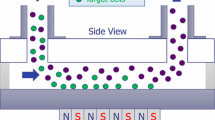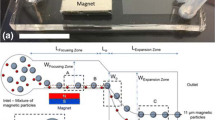Abstract
There has been a recent surge of research output on magnetophoretic lab-on-a-chip systems due to their prospective use in a range of applications in the life sciences and clinical diagnostics. Manifold applications for batch-mode or continuous-flow magnetophoretic separations of cells, proteins, and nucleic acids are found in bioanalytics, cell biology, and clinical diagnostics. To ensure stable hydrodynamic conditions and thus reproducible separation, state-of-the-art magnetophoretic lab-on-a-chip systems have been based on pressure-driven flow (Gijs in Microfluid Nanofluid 1:22–40, 2004; Pamme and Manz in Anal Chem 76:7250–7256, 2004; Pamme in Lab Chip 7:1644–1659, 2007; Karle et al. in Lab Chip 10:3284–3290, 2010), which involves rather bulky and costly instrumentation. In a flow-based system, suspended particles are following the liquid phase as a result of the Stokes drag, thus being fully exposed to divergent flow lines around obstacles and pump-induced pressure fluctuations. To eventually achieve more stable hydrodynamic conditions, improved control of magnetic particles, a more compact instrumentation footprint, and integration of high-performance upstream sample preparation, this work introduces a novel two-dimensional particle separation principle by combining magnetic deflection with centrifugal sedimentation in a stopped-flow mode (i.e., mere particle sedimentation). The experimental parameters governing our centrifugo-magnetophoretic system are the strength and orientation of the co-rotating magnetic field, the rotationally induced centrifugal field, and the size-dependent Stokes drag of the various particles with respect to the (residual) liquid phase. In this work, the following set of basic functional modes is demonstrated as proof-of-concept: separation of magnetic from non-magnetic particles, routing of magnetic particles based on control of the spin speed, and size separation of various magnetic particles. Finally, a biomimetic application involving the separation of particles representing healthy cells from a very small concentration of magnetic particles of a similar size, mass and magnetization as a immuno-magnetically tagged target cell, for instance mimicking a circulating tumor cell.






Similar content being viewed by others
References
Beebe D, Mensing G, Walker G (2002) Physics and applications of microfluidics in biology. Annu Rev Biomed Eng 4:261–286
Brenner T, Glatzel T, Zengerle T, Ducrée J (2005) Frequency-dependent transversal flow control in centrifugal microfluidics. Lab Chip 5:146–150
Burger R, Ducrée J (2012) Handling and analysis of cells and bioparticles on centrifugal microfluidic platforms. Expert Rev Mol Diagn 12(4):407–421. doi:10.1586/ERM.12.28 (in press)
Cho Y, Lee J, Park J, Lee B, Lee Y, Ko C (2007) One-step pathogen specific DNA extraction from whole blood on a centrifugal microfluidic device. Lab Chip 7:565–573
Ducrée J, Haeberle S, Lutz S, Pausch S, von Stetten F, Zengerle R (2007) The centrifugal microfluidic bio-disk platform. J Micromech Microeng 17:103–115
Finite Element Method Magnetics (FEMM) http://www.femm.info. Accessed Jul 2010
Gijs M (2004) Magnetic bead handling on-chip: new opportunities for analytical applications. Microfluid Nanofluid 1:22–40
Gorkin R, Park J, Siegrist J, Amasia M, Lee B, Park J, Kim J, Kim H, Madou M, Cho Y (2010) Centrifugal microfluidics for biomedical applications. Lab Chip 10:1758–1773
Grumann M, Brenner T, Beer C, Zengerle R, Ducrée J (2005) Visualization of flow patterning in high-speed centrifugal microfluidics. Rev Sci Instrum 76:025101
Haeberle S, Zengerle R (2007) Microfluidic platforms for lab-on-a-chip applications. Lab Chip 7:1094–1110
Haeberle S, Brenner T, Zengerle R, Ducrée J (2006) Centrifugal extraction of plasma from whole blood on a rotating disk. Lab Chip 6:776–781
Hosokawa K, Sato K, Ichikawa N, Maeda M (2004) Power-free poly(dimethylsiloxane) microfluidic devices for gold nanoparticle-based DNA analysis. Lab Chip 4:181–185
Karle M, Miwa J, Czilwik G, Auwärter V, Roth G, Zengerle R, von Stetten F (2010) Continuous microfluidic DNA extraction using phase-transfer. Lab Chip 10:3284–3290
Madou M (2002) Fundamentals of microfabrication, 2nd edn. CRC Press, Boca Raton
Madou M, Zoval J, Jia G, Kido H, Kim J, Kim N (2006) Lab on a CD. Annu Rev Biomed Eng 8:601–628
Manz A, Graber N, Widmer H (1990) Miniaturized total chemical analysis systems: a novel concept for chemical sensing. Sens Actuators B 1:244–248
Melle S, Rubio M, Fuller G (2001) Time scaling regimes in aggregation of magnetic dipolar particles: scattering dichroism results. Phys Rev Lett 87:115501
Pamme N (2006) Magnetism and microfluidics. Lab Chip 6:24–38
Pamme N (2007) Critical review: continuous flow separations in microfluidic devices. Lab Chip 7:1644–1659
Pamme N, Manz A (2004) On-chip free-flow magnetophoresis: continuous flow separation of magnetic particles and agglomerates. Anal Chem 76:7250–7256
Pamme N, Wilhelm C (2006) Continuous sorting of magnetic cells via on-chip free-flow magnetophoresis. Lab Chip 6:974–980
Pappas D, Wang K (2007) Cellular separations: a review of new challenges in analytical chemistry. Anal Chim Acta 1:26–35
Siegrist J, Peytavi R, Bergeron M, Madou M (2009) Microfluidics for IVD analysis: triumphs and hurdles of centrifugal platforms—Part 1: molecular fundamentals. IVD Tech 15:22–26
Silbert L (2010) Jamming of frictional spheres and random loose packing. Soft Matter 6:2918–2924
Steigert J, Brenner T, Grumann M, Riegger L, Lutz S, Zengerle R, Ducrée J (2007a) Integrated siphon-based metering and sedimentation of whole blood on a hydrophilic lab-on-a-disk. Biomed Microdevices 9:675–679
Steigert J, Haeberle S, Müller C, Steinert CP, Gottschlich N, Reinecke H, Rühe J, Zengerle R, Ducrée J (2007b) Rapid prototyping of microfluidic chips in COC. J Micromech Microeng 17(2):333–341
ThermoScientific KingFisher http://www.thermoscientific.com/wps/portal/ts/products/detail?productId=11960640. Accessed Nov 2010
Thorsen T, Maerkl S, Quake S (2002) Microfluidic large-scale integration. Science 298:580–584
Veridex http://www.veridex.com. Accessed Oct 2010
Xia Y, Whitesides G (1998) Soft lithography. Annu Rev Mat Sci 28:153–184
Acknowledgments
This work was supported by the Science Foundation of Ireland under Grant No. 10/CE/B1821.
Author information
Authors and Affiliations
Corresponding author
Rights and permissions
About this article
Cite this article
Kirby, D., Siegrist, J., Kijanka, G. et al. Centrifugo-magnetophoretic particle separation. Microfluid Nanofluid 13, 899–908 (2012). https://doi.org/10.1007/s10404-012-1007-6
Received:
Accepted:
Published:
Issue Date:
DOI: https://doi.org/10.1007/s10404-012-1007-6




